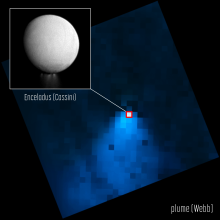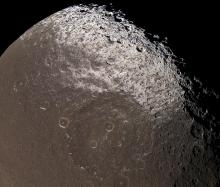Listen to today's episode of StarDate on the web the same day it airs in high-quality streaming audio without any extra ads or announcements. Choose a $8 one-month pass, or listen every day for a year for just $30.
You are here
Moon and Saturn
To the eye alone, the colors of one of the moons of Saturn are subtle. One hemisphere of Tethys is almost pure white — the result of a steady “snow” of ice grains from one of Saturn’s rings. The other hemisphere is tinted light yellow by radiation trapped in Saturn’s magnetic field. And the zone between the two faces is pale blue.
If you crank up the intensity of the colors, though, some odd features pop out: long, thin arcs that are bright red. They’re no more than a few miles wide, but up to about 150 miles long.
Tethys is Saturn’s fifth-largest moon. It’s about 660 miles wide. It’s made almost entirely of frozen water, with just a dab of rock mixed in. Its most prominent feature is a giant crater. The impact that created it almost blasted the moon to bits.
The red arcs were discovered in images from the Cassini spacecraft, which revealed three sets of them. They’re in the northern half of the hemisphere that always faces away from Saturn. Some of them slice across the big crater, suggesting that it had nothing to do with their formation.
Scientists aren’t sure just why the arcs are red. One idea is that they’re cracks in the crust that allow minerals inside Tethys to bubble to the surface. But the mystery of the red arcs remains unsolved.
Saturn tags along with the Moon, which is almost at last quarter, early tomorrow. They rise about 3 a.m. Saturn looks like a bright star, directly above the Moon at first light.
Script by Damond Benningfield






